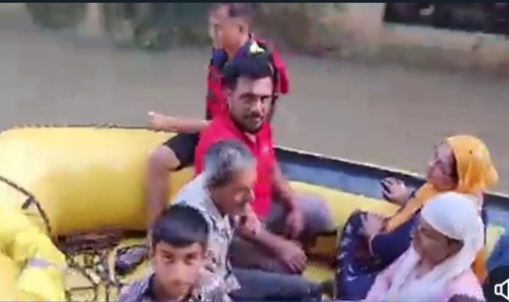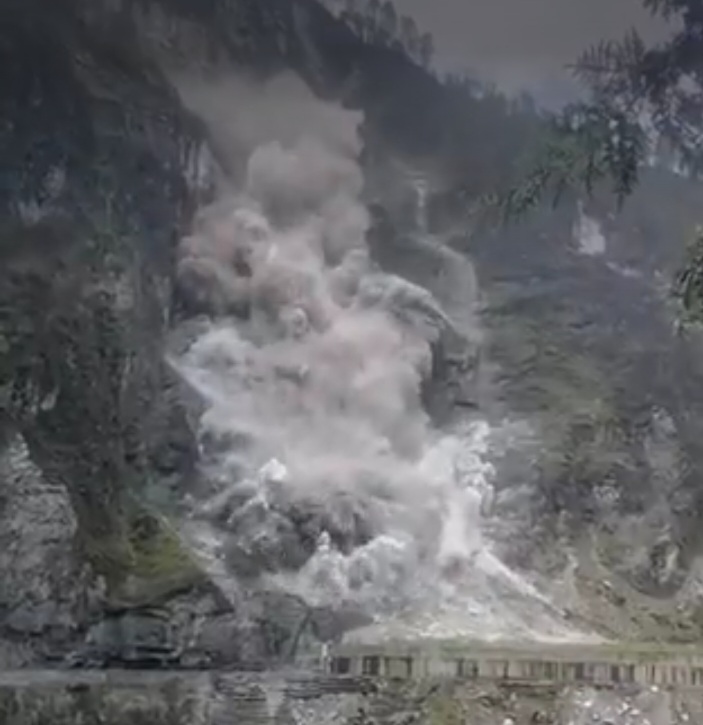Dehradun: A giant 'explosive' landslide erupted near the Patalganga Langsi tunnel in Chamoli district that has literally rocked entire Badrinath Dham
in Uttarakhand's Char Dham circuit, blocking the Joshimath-Badrinath highway and stranding pilgrims on both sides.
The alarming visuals of the Patalganga landslide today is a proof enough to say that the mountains are bleeding due to the reckless construction mania that plagues the government development agenda.
Over 90 families have been displaced in the flood hit lower areas of the state over the days.
This incident enveloped the area in a thick cloud of dust and debris, raising concerns among the local population and travelers.
The Uttarakhand government has issued an official alert for the traveling public.
Locals suspect that explosives used in the under-construction Langsi tunnel might have weakened the fragile hillsides, leading to such devastating landslides, especially during rains.
This landslide came hot on the heels of the subsidence of Joshimath tragedy that had killed several people and washing away houses and road strectehes, marooning the the pilgrimage centre for months.

Although environmentalists have yet to pinpoint the exact cause, the government and construction companies are facing backlash from the NGOs and locals, who accuse them of ignoring the ecological fragility of the mountains in pursuit of development.
The incident has sparked anger among locals and NGOs, who criticize the government and construction firms for their reckless expansion, which endangers both lives and livelihoods.
The soil erosion and flash floods from the wounded mountains have triggered floods in the plains.
So far in recent floods in the state, about 90 families have been displaced due to the landslide, and relief centers have been established at four to five locations to assist those displaced.
 NDRF and Uttarakhand rescue team saved many lives by rescuing the submerged people from the low lying area.
NDRF and Uttarakhand rescue team saved many lives by rescuing the submerged people from the low lying area.
But today's Patalganga catastrophic event has been described by onlookers as a "blood-curdling sight," with clouds of dust lingering as the mountain crumbled.
Anoop Nautiyal, President of the SDC Foundation, has attributed this disaster to two primary factors: flawed development models and the escalating climate crisis.
Nautiyal said, "Until our governments, corporates, and the public acknowledge that we are on the wrong path and take corrective measures, such disasters will unfortunately continue to increase."
Patalganga scene is a stark reminder of the urgent need for sustainable development and climate action.
As the dust settles, the call for change grows louder, urging immediate attention and action to prevent further devastation.
Several routes in the area remain closed, complicating rescue and relief efforts.
The Chief Minister, Pushkar Singh Dhami, has assured every possible assistance to the affected families, including quick distribution of compensation and relief.
Dhami visited several flood-affected areas to assess the damage and ensure relief measures were in place.
The areas he inspected include:
1. Chakrapur - He visited this area to inspect the damage caused by floods and landslides.
2. Amau - Another flood-affected area where he assessed the extent of damage and interacted with the affected residents.
3. Khatima Bazaar He visited the market area to review the impact of waterlogging and flooding.
4. Railway Crossing in Khatima - The CM inspected this location to understand the impact on transportation and infrastructure.
5. Awas Vikas and Pakariya- These residential areas were also part of his inspection tour to ensure adequate relief measures were being implemented.
6. Purnagiri Colony - He assessed the damage and directed municipal authorities to rectify waterlogging issues and repair.
The mountains are bleeding. But the Government continues to dig and cut them in the name of development. 
The highway was restored for traffic at 10 pm on July 10 and thousands of passengers breathed easy and started their journey back home.










